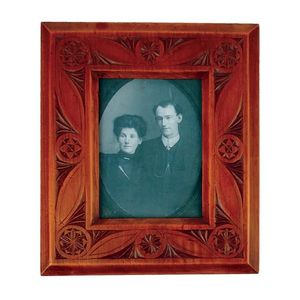Gilded Kiwi Beak Brooch with Engraved Mounts and Chain
You must be a subscriber, and be logged in to view price and dealer details.
Subscribe Now to view actual auction price for this item
When you subscribe, you have the option of setting the currency in which to display prices to $Au, $US, $NZ or Stg.
- Chip Carving - Chip carving, also known as spoon carving is a traditional woodworking technique that involves removing small, V-shaped chips of wood from a flat surface using a carving knife. The technique is often used to create intricate geometric patterns and designs on wooden objects such as bowls, spoons, and boxes.
It is a form of relief carving, which means that the design is raised above the surface of the wood rather than being carved into it. It's a relatively simple technique that does not require a great deal of skill or experience, making it a popular choice for both beginners and experienced woodworkers. - Gilding - Gilding is a method of ornamentation whereby a thin sheet of gold metal is applied to items made of wood, leather, ceramics, glass and silver for decorative purposes.
For furniture including mirrors, the sheet of gold is usually applied over a coating of gesso. Gesso is a mixture of plaster of Paris and gypsum mixed with water and then applied to the carved wooden frames of mirrors and picture frames as a base for applying the gold leaf. After numerous coats of gesso have been applied, allowed to dry and then sanded a coat of "bole", a usually red coloured mixture of clay and glue is brushed on and allowed to dry, after which the gold leaf is applied. Over time parts of the gilding will rub off so the base colour can be seen. In water gilding, this was generally a blue colour, while in oil gilding, the under layer was often yellow. In Victorian times, gilders frequently used red as a pigment beneath the gold leaf.
Metal was often gilded by a process known as fire gilding. Gold mixed with mercury was applied and heated, causing the mercury to evaporate, the long-term effect of which was to kill or disable the craftsman or woman from mercury poisoning. The pursuit of beauty has claimed many victims, not the least of which were the artists who made those pieces so highly sought after today. - Kauri - An evergreen conifer tree associated with New Zealand, but also grown in northern Australia, and islands around the Pacific rim including Borneo, Vanuatu and New Guinea. The timber is generally golden in colour, and straight grained without much knotting.
A by-product of the kauri tree was the kauri gum, the fossilised resin extracted from the tree. The gum was obtained through digging, fossicking in treetops, or more drastically, by bleeding live trees. Kauri gum was used in the manufacture of varnishes and other resin-based products, and also crafted into jewellery, keepsakes, and small decorative items.
Kauri forests were prolific in the north of the North Island of New Zealand. European settlers in the 1700 and 1800s realised that the timber from these tall trees with broad trunks would be ideal for ship building and construction and a thriving industry was established harvesting the kauri tree. The forests were substantially reduced, and now the remaining Kauri trees that grow in New Zealand are protected, and there are reserves in various areas of the North Island.
The remaining stands of kauri in New Zealand are under threat from "kauri disease", a microscopic organism that causes dieback in the trees, with vast tracts either dead or dying.
This item has been included into following indexes:
Visually similar items

Artist unknown. Bringing in the Catch oil on board. Signed lower right - indistinct 15 x 20 cm

Possibly 14th/15th century book of hours vellum page featuring the prayer in the garden of Gethsemane & the Last supper. Condition good, some losses to the paint, age related wear. Dimensions of frame - 21.2 x 15.8 cm

Decorative still life oil on panel, signed lower right, gilt frame, approx 23 cm x 18 cm

Ernest Jean Delahaye (1855-1921). Soldier guarding near a coastal camp. Oil on canvas, signed, location and dated '1915' at the bottom left. Approx 26.5 cm x 35 cm
